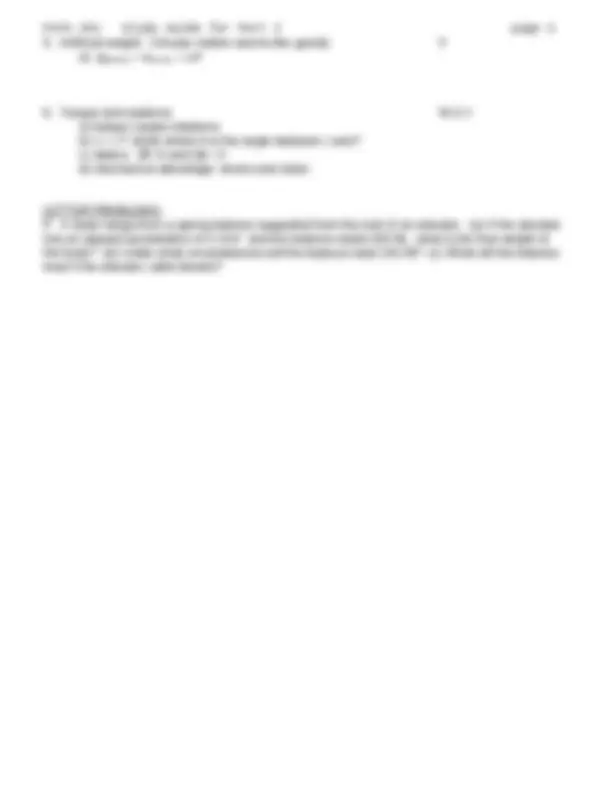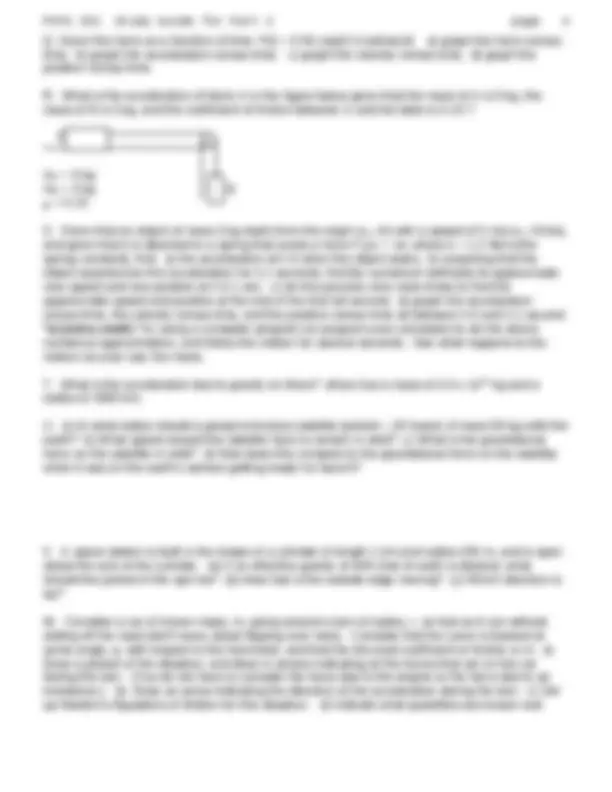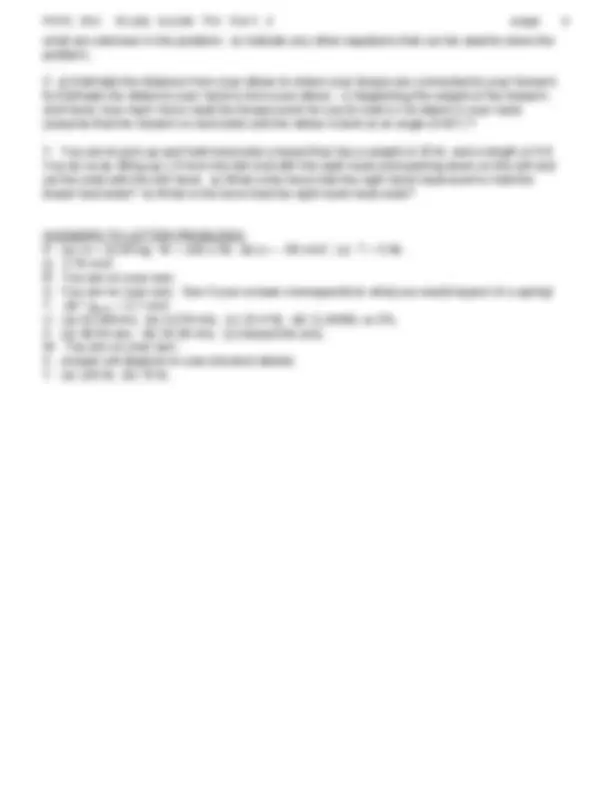





Study with the several resources on Docsity

Earn points by helping other students or get them with a premium plan


Prepare for your exams
Study with the several resources on Docsity

Earn points to download
Earn points by helping other students or get them with a premium plan
Community
Ask the community for help and clear up your study doubts
Discover the best universities in your country according to Docsity users
Free resources
Download our free guides on studying techniques, anxiety management strategies, and thesis advice from Docsity tutors
This study guide covers the second part of phys 201 course, focusing on forces and motion, including two dimensional motion, newton's laws of motion, gravity, torque, and rotations. Topics include projectile motion, uniform circular motion, relative velocity, inertial mass, newton's second law, gravitational force, and torque. The guide includes letter problems and answers.
Typology: Study notes
1 / 5

This page cannot be seen from the preview
Don't miss anything!




In this second part of the course we consider: (a) two dimensional motion [combining 1-D motion with vectors]; (b) the relation between force and motion [which introduces the concept of mass and Newton's three laws of motion]; and (c) one of the four fundamental forces: gravity. We begin this section by looking at two dimensional motion. This combines the ideas of position, velocity, and acceleration with the idea of a vector (having components). We look at three special cases: trajectory motion, uniform circular motion, and relative velocity. We next introduce the concept of INERTIAL MASS as a basic quality of matter. It is the quality that determines how a force will affect the motion of an object. This extremely important relation between force and motion is contained in a very simple equation: F = m a, called NEWTON'S SECOND LAW. We also consider Newton's first (which is a special case of Newton's Second Law, and Newton's third law which is important in determining who is pushing on whom. As an important example of force, we consider Newton's Law of Gravity and how it relates to the concept of GRAVITATIONAL MASS. Next we consider the concept of torque (or angular force) and its relation to rotations and force.
river is 200 meters wide? c) What direction should he head his boat if he wants to just get across the river in the least time? d) How long will be the least time? ANSWERS TO LETTER PROBLEMS: M. a) 75.01 m; b) 3.58 sec. N. a) T = 1 day = 86,400 sec; b) 463 m/s = 1,039 mph; c) 7.27 x 10-5^ rad/s; d) YES; e) 0.034 m/s²r = v ; f) 0 m/s²r = v. O. a) 23.6° upstream; b) 43.6 sec.; c) straight across; d) 40 sec.
Q. Given the force as a function of time: F(t) = 5 Nt cos[(0.3 rad/sec)t] a) graph the force versus time; b) graph the acceleration versus time; c) graph the velocity versus time; d) graph the position versus time. R. What is the acceleration of block A in the figure below given that the mass of A is 5 kg, the mass of B is 3 kg, and the coefficient of friction between A and the table is 0.15? A mA = 5 kg mB = 3 kg B = 0. S. Given that an object of mass 3 kg starts from the origin (xo =0) with a speed of 5 m/s (vo =5m/s), and given that it is attached to a spring that exerts a force Fs(x) = -kx where k = 1.2 Nt/m [the spring constant], find: a) the acceleration at t=0 when the object starts; b) assuming that the object experiences this acceleration for 0.1 seconds, find [by numerical methods] its approximate new speed and new position at t=0.1 sec; c) do this process nine more times to find the approximate speed and position at the end of the first full second; d) graph the acceleration versus time, the velocity versus time, and the position versus time all between t=0 and t=1 second. *e) [extra credit ] Try using a computer program (or program your calculator) to do the above numerical approximation, and follow the motion for several seconds. See what happens to the motion as your vary the mass. T. What is the acceleration due to gravity on Mars? (Mars has a mass of 6.4 x 10^23 kg and a radius of 3400 km. U. a) At what radius should a geosynchronous satellite (period = 24 hours) of mass 50 kg orbit the earth? b) What speed should this satellite have to remain in orbit? c) What is the gravitational force on the satellite in orbit? d) How does this compare to the gravitational force on the satellite when it was on the earth's surface getting ready for launch? V. A space station is built in the shape of a cylinder of length 1 km and radius 200 m, and is spun about the axis of the cylinder. (a) If an effective gravity of 60% that of earth is desired, what should the period of the spin be? (b) How fast is the outside edge moving? (c) Which direction is up? W. Consider a car of known mass, m, going around a turn of radius, r, as fast as it can without sliding off the road (don't worry about flipping over here). Consider that the curve is banked at some angle, q, with respect to the horizontal, and that the tire-road coefficient of friction is m. a) Draw a picture of the situation, and draw in arrows indicating all the forces that act on the car during the turn. (You do not have to consider the force due to the engine or the force due to air resistance.) b) Draw an arrow indicating the direction of the acceleration during the turn. c) Set up Newton's Equations of Motion for this situation. d) Indicate what quantities are knwon and
what are unknown in the problem. e) Indicate any other equations that can be used to solve the problem. X. a) Estimate the distance from your elbow to where your biceps are connected to your forearm. b) Estimate the distance your hand is from your elbow. c) Neglecting the weight of the forearm and hand, how much force must the biceps exert for you to hold a 2 lb object in your hand (assume that the forearm is horizontal and the elbow is bent at an angle of 90°)? Y. You are to pick up and hold horizontal a board that has a weight of 25 lb. and a length of 8 ft. You do so by lifting up 1 ft from the left end with the right hand and pushing down on the left end (at the end) with the left hand. a) What is the force that the right hand must exert to hold the board horizontal? b) What is the force that the right hand must exert? ANSWERS TO LETTER PROBLEMS: P. (a) m = 16.95 kg; W = 166.1 Nt; (b) a = - .95 m/s²r = v ; (c) T = 0 Nt. Q. 2.76 m/s²r = v. R. You are on your own. S. You are on your own. See if your answer corresponds to what you would expect of a spring! T. .38 * gearth = 3.7 m/s²r = v. U. (a) 42,300 km; (b) 3,076 m/s; (c) 22.4 Nt; (d) 11.8/490, or 2%. V. (a) 36.64 sec; (b) 34.29 m/s; (c) toward the axis. W. You are on your own. X. answer will depend on your physical stature. Y. (a) 100 lb; (b) 75 lb.